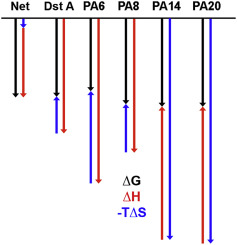Our official English website, www.x-mol.net, welcomes your
feedback! (Note: you will need to create a separate account there.)
DNA binding thermodynamics and site stoichiometry as a function of polyamide size.
Biochimie ( IF 3.3 ) Pub Date : 2019-07-31 , DOI: 10.1016/j.biochi.2019.07.021 Yang Song 1 , Jacquelyn Niederschulte 1 , Kristin N Bales 1 , Andrew H Park 1 , James K Bashkin 1 , Cynthia M Dupureur 1
Biochimie ( IF 3.3 ) Pub Date : 2019-07-31 , DOI: 10.1016/j.biochi.2019.07.021 Yang Song 1 , Jacquelyn Niederschulte 1 , Kristin N Bales 1 , Andrew H Park 1 , James K Bashkin 1 , Cynthia M Dupureur 1
Affiliation

|
The interactions of 6-8 ring hairpin polyamides (PAs) with the minor groove of DNA have been investigated extensively. More recent studies of large antiviral PAs (14-20 rings) active against small DNA tumor viruses lead to questions regarding the extent to which the DNA binding behaviors of the well studied, smaller PAs can be reliably extrapolated to the larger ones. Described here is the first reported study of hairpin PA-DNA binding thermodynamics as a function of PA size (6-20 rings). All PAs exhibit binding affinity in the low nM to upper pM range, which indicates that affinity is not a discriminator of antiviral activity. Unlike the smaller PAs, a 20-ring PA does not appreciably dissociate from DNA in competition experiments, which indicates very long residence time that is consistent with antiviral activity. While the DNA binding thermodynamics for the smaller antivirally inactive 6- and 8-ring PAs is clearly enthalpically driven, the larger antiviral PAs (14- and 20-rings) exhibit strongly entropically-driven DNA binding. These distinct energetic signatures indicate that different types of interactions drive these associations. In DNA binding site stoichiometry experiments conducted at both nM and μM concentrations, all PAs except the 6-ring PA bind an isolated site with site stoichiometry of at least two PAs per recognition sequence. Electrostatic contributions to DNA binding affinity are small for all PAs and not correlated with PA size but weakly correlated with the number of imidazole residues. Altogether, these results indicate that DNA binding behaviors of smaller hairpin PAs do not necessarily reflect those of larger PAs. These are vital considerations in the development of hairpin PAs for biological use.
中文翻译:

DNA结合热力学和位点化学计量随聚酰胺尺寸的变化而变化。
广泛研究了6-8个环发夹式聚酰胺(PAs)与DNA小沟的相互作用。对小型DNA肿瘤病毒有活性的大型抗病毒PA(14-20个环)的最新研究引起了人们对研究充分的DNA结合行为的程度的质疑,较小的PA可以可靠地外推到较大的PA。这里描述的是第一个报道的发夹PA-DNA结合热力学随PA大小变化(6-20个环)的研究。所有PA在低nM到较高pM范围内均表现出结合亲和力,这表明亲和力不是抗病毒活性的鉴别剂。与较小的PA不同,在竞争实验中20环PA不会从DNA上明显解离,这表明与抗病毒活性一致的非常长的停留时间。显然,较小的抗病毒非活性6环和8环PA的DNA结合热力学是由焓驱动的,而较大的抗病毒PA(14和20环)表现出强烈的熵驱动的DNA结合。这些不同的能量签名表明,不同类型的交互驱动这些关联。在以nM和μM浓度进行的DNA结合位点化学计量实验中,除6环PA外,所有PA均结合了一个分离的位点,每个识别序列的位点化学计量为至少两个PA。对于所有PA,静电对DNA结合亲和力的贡献均很小,与PA的大小无关,但与咪唑残基的数量之间的相关性很小。总之,这些结果表明,较小发夹型PA的DNA结合行为不一定反映较大PA的DNA结合行为。
更新日期:2019-07-31
中文翻译:

DNA结合热力学和位点化学计量随聚酰胺尺寸的变化而变化。
广泛研究了6-8个环发夹式聚酰胺(PAs)与DNA小沟的相互作用。对小型DNA肿瘤病毒有活性的大型抗病毒PA(14-20个环)的最新研究引起了人们对研究充分的DNA结合行为的程度的质疑,较小的PA可以可靠地外推到较大的PA。这里描述的是第一个报道的发夹PA-DNA结合热力学随PA大小变化(6-20个环)的研究。所有PA在低nM到较高pM范围内均表现出结合亲和力,这表明亲和力不是抗病毒活性的鉴别剂。与较小的PA不同,在竞争实验中20环PA不会从DNA上明显解离,这表明与抗病毒活性一致的非常长的停留时间。显然,较小的抗病毒非活性6环和8环PA的DNA结合热力学是由焓驱动的,而较大的抗病毒PA(14和20环)表现出强烈的熵驱动的DNA结合。这些不同的能量签名表明,不同类型的交互驱动这些关联。在以nM和μM浓度进行的DNA结合位点化学计量实验中,除6环PA外,所有PA均结合了一个分离的位点,每个识别序列的位点化学计量为至少两个PA。对于所有PA,静电对DNA结合亲和力的贡献均很小,与PA的大小无关,但与咪唑残基的数量之间的相关性很小。总之,这些结果表明,较小发夹型PA的DNA结合行为不一定反映较大PA的DNA结合行为。











































 京公网安备 11010802027423号
京公网安备 11010802027423号